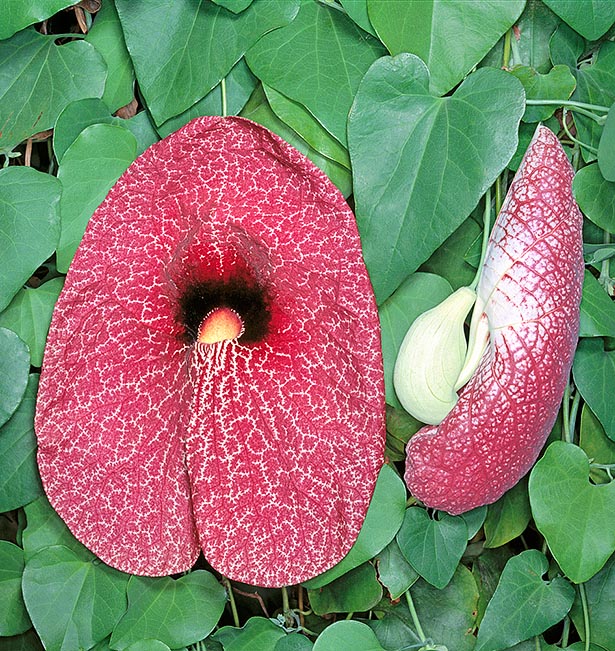Family : Aristolochiaceae

Text © Pietro Puccio

English translation by Mario Beltramini

Native to Brazil, Colombia and Panama, Aristolochia gigantea is an evergreen climber with even 10 m long stems lignifying at the base. The fruits are drooping, with dark purple arabesques and reach 20 cm with a disturbing orange-yellow fauces surrounded on top by a black spot with white hairs that favour the entry to passing by pollinating insect, but prevent its exit till when fecundation is done © Giuseppe Mazza
The name of the genus comes from the combination of the Greek words “aristos” = the best, and “locheia” = delivery, with reference to the belief that the plant should help the childbirth; the name of the species is the Latin word “gigantea” = giant, with obvious reference.
Common names: “Brazilian Dutchman’s pipe”, “giant pelican flower” (English); “grand aristolochia du Brésil” (French); “papo-de-peru”, “papo-de-peru-grande”, “papo-de-peru-babada”, “mil-homens”, “jarra-açu”, “aristolóquia”, “jarrinha”, “cipó-mil-homens” (Portuguese); “aristoloquia gigante”, “oreja de elefante”, “pipa del holandés” (Spanish); “Pelikanblume”, “Pfeifenwinde” (German).
Evergreen, climbing plant, with stems lignifying at the base, long up to 10 m. It has alternate obovate-cordate leaves with sharp pale green apex, glabrate on the upper side, with a thin down on the lower one, long up to about 16 cm and 10 cm broad, on 4-6 cm long petioles.
The flowers, on hanging peduncles, are axillar, solitary, without petals, with a calyx formed by an inflated and bent tube, about 12 cm long, of a greenish-white colour, which widens taking the shape of a trumpet with vertical elliptic edge, deeply lobed at the base, long up to about 20 cm and 12 cm broad, with white background colour, later tending to yellow, thickly dotted of dark purple.
The orange-yellow fauces is surrounded on the upper part by a black dot and is furnished with white hair which help the entrance of the pollinating insect, but hinder its exit until when the fecundation is happened; the flowers are almost odourless, if compared to many plants of the genus, which emit a stink of rotten flesh. In the aged plants, the flowers can be produced also directly from the stem (cauliflory).
The fruits are greyish, oblong capsules, long about 8 cm and 3 cm broad, dehiscent (fruits which open spontaneously when ripe, along the lines of least resistance thus freeing the seeds), containing several flat, thin and chartaceous seeds, long about 7 mm and 5 mm broad. It usually and easily reproduces by seed, but also by cutting.
Robust climber, very ornamental, due to its unusually shaped huge flowers, cultivable in full sun or mid shade in the tropical, subtropical and marginally warm temperate climates, being damaged in the aerial part already around -1/-2 °C, but resisting to some grades less at its roots level; it is not particular in soil, even if preferring rich of organic substance, draining grounds, kept humid during the vegetative time.
It is cultivable in pot in greenhouses, winter gardens and luminous verandas, with temperatures never inferior than 12/14 °C, best around 20/22 °C. The plant, like others of the same genus, contain some toxic substances, in particular the aristolochic acid, nephrotoxic and carcinogen.
Synonyms: Howardia gigantea (Mart. & Zucc.) Klotzsch (1859); Aristolochia clypeata Linden & André (1870); Aristolochia sylvicola Standl. (1925).
→ To appreciate the biodiversity within the family ARISTOLOCHIACEAE please click here.
